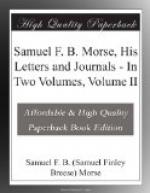“The truth is Mr. Vail had no natural aptitude for executive work, and he had a temper somewhat variable and unhappy. He and I got along very well together until I determined to order my own instruments, his being too heavy and too difficult, as I thought, for an operator to handle while receiving. We had our instruments made by the same maker—Clark & Co., Philadelphia. Yet even that did not greatly separate us, and we were always friends. About some things his notions were very crude. It was under his guidance that David Brooks, Henry C. Hepburn and I, in 1845, undertook to insulate the line from Lancaster to Harrisburg, Pennsylvania, by saturating bits of cotton cloth in beeswax and wrapping them round projecting arms. The bees enjoyed it greatly, but it spoiled our work.
“But I have no desire to criticize him. He seemed to me to have great opportunities which he did not use. He might have had, I thought, the register work of the country and secured a large business. But it went from him to others, and so he left the field.”
This eventful year of 1848 closed with the great telegraph suits in full swing, but with the inventor calm under all his trials. In a letter, of December 18, to his brother Sidney, who had now returned to America, he says: “My affairs (Telegraphically) are only under a slight mist, hardly a cloud; I see through the mist already.”
And in another part of this letter he says: “I may see you at the end of the week. If I can bring Sarah down with me, I will, to spend Christmas, but the weather may change and prevent. What weather! I am working on the lawn as if it were spring. You have no idea how lovely this spot is. Not a day passes that I do not feel it. If I have trouble abroad, I have peace, and love, and happiness at home. My sweet wife I find, indeed, a rich treasure. Uniformly cheerful and most affectionate, she makes sunshine all the day. God’s gifts are worthy of the giver.”
It was in the early days of 1849 that a gift of another kind was received by him which could not fail to gratify him. This was a decoration, the “Nichan Iftikar” or “Order of Glory,” presented to him by the Sultan of Turkey, the first and only decoration which the Sultan of the Ottoman Empire had conferred upon a citizen of the United States. It was a beautiful specimen of the jeweller’s art, the monogram of the Sultan in gold, surrounded by 130 diamonds in a graceful design. It was accompanied by a diploma (or berait) in Turkish, which being translated reads:—
IN THE NAME OF HIM
SULTAN ABDUL HAMID KHAN
Son of Mahmoud Khan, son of Abdul Hamid Khan—may
he ever be victorious!
The object of the present sovereign decoration of Noble Exalted Glory, of Elevated Place, and of this Illustrious World Conquering Monogram is as follows:




